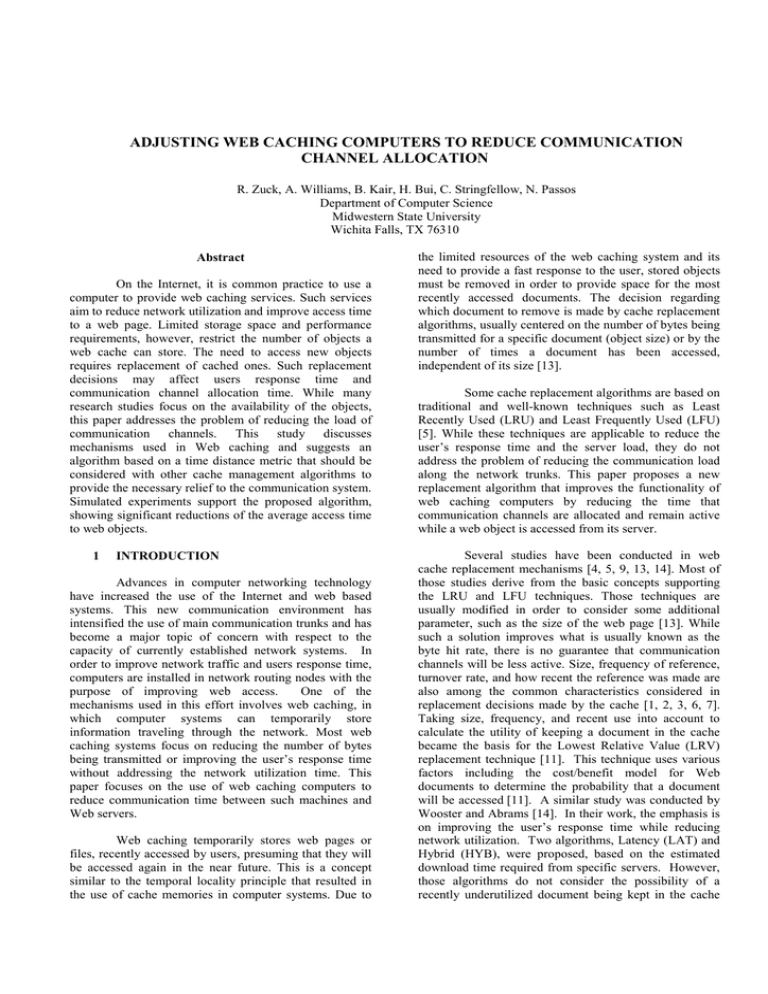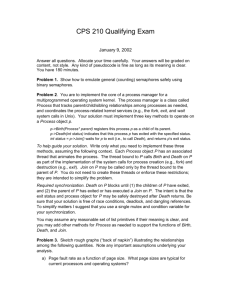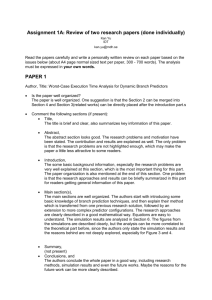ADJUSTING WEB CACHING COMPUTERS TO REDUCE COMMUNICATION CHANNEL ALLOCATION
advertisement

ADJUSTING WEB CACHING COMPUTERS TO REDUCE COMMUNICATION
CHANNEL ALLOCATION
R. Zuck, A. Williams, B. Kair, H. Bui, C. Stringfellow, N. Passos
Department of Computer Science
Midwestern State University
Wichita Falls, TX 76310
Abstract
On the Internet, it is common practice to use a
computer to provide web caching services. Such services
aim to reduce network utilization and improve access time
to a web page. Limited storage space and performance
requirements, however, restrict the number of objects a
web cache can store. The need to access new objects
requires replacement of cached ones. Such replacement
decisions may affect users response time and
communication channel allocation time. While many
research studies focus on the availability of the objects,
this paper addresses the problem of reducing the load of
communication channels. This study discusses
mechanisms used in Web caching and suggests an
algorithm based on a time distance metric that should be
considered with other cache management algorithms to
provide the necessary relief to the communication system.
Simulated experiments support the proposed algorithm,
showing significant reductions of the average access time
to web objects.
1
INTRODUCTION
Advances in computer networking technology
have increased the use of the Internet and web based
systems. This new communication environment has
intensified the use of main communication trunks and has
become a major topic of concern with respect to the
capacity of currently established network systems. In
order to improve network traffic and users response time,
computers are installed in network routing nodes with the
purpose of improving web access.
One of the
mechanisms used in this effort involves web caching, in
which computer systems can temporarily store
information traveling through the network. Most web
caching systems focus on reducing the number of bytes
being transmitted or improving the user’s response time
without addressing the network utilization time. This
paper focuses on the use of web caching computers to
reduce communication time between such machines and
Web servers.
Web caching temporarily stores web pages or
files, recently accessed by users, presuming that they will
be accessed again in the near future. This is a concept
similar to the temporal locality principle that resulted in
the use of cache memories in computer systems. Due to
the limited resources of the web caching system and its
need to provide a fast response to the user, stored objects
must be removed in order to provide space for the most
recently accessed documents. The decision regarding
which document to remove is made by cache replacement
algorithms, usually centered on the number of bytes being
transmitted for a specific document (object size) or by the
number of times a document has been accessed,
independent of its size [13].
Some cache replacement algorithms are based on
traditional and well-known techniques such as Least
Recently Used (LRU) and Least Frequently Used (LFU)
[5]. While these techniques are applicable to reduce the
user’s response time and the server load, they do not
address the problem of reducing the communication load
along the network trunks. This paper proposes a new
replacement algorithm that improves the functionality of
web caching computers by reducing the time that
communication channels are allocated and remain active
while a web object is accessed from its server.
Several studies have been conducted in web
cache replacement mechanisms [4, 5, 9, 13, 14]. Most of
those studies derive from the basic concepts supporting
the LRU and LFU techniques. Those techniques are
usually modified in order to consider some additional
parameter, such as the size of the web page [13]. While
such a solution improves what is usually known as the
byte hit rate, there is no guarantee that communication
channels will be less active. Size, frequency of reference,
turnover rate, and how recent the reference was made are
also among the common characteristics considered in
replacement decisions made by the cache [1, 2, 3, 6, 7].
Taking size, frequency, and recent use into account to
calculate the utility of keeping a document in the cache
became the basis for the Lowest Relative Value (LRV)
replacement technique [11]. This technique uses various
factors including the cost/benefit model for Web
documents to determine the probability that a document
will be accessed [11]. A similar study was conducted by
Wooster and Abrams [14]. In their work, the emphasis is
on improving the user’s response time while reducing
network utilization. Two algorithms, Latency (LAT) and
Hybrid (HYB), were proposed, based on the estimated
download time required from specific servers. However,
those algorithms do not consider the possibility of a
recently underutilized document being kept in the cache
for extended periods of time. In this paper, a combination
of the LRU algorithm and communication load
parameters is used to improve the network load and
eliminate underutilized documents from the cache.
Network access time is also dependent on the
physical characteristics of the network. Bandwidth, speed
of the server and user equipment, and propagation time all
affect the response time perceived by a user. Assuming
that the propagation delay cannot be improved,
Padmanabhan and Mogul developed a prediction and
prefetching technique that helps reduce this type of
latency [10].
Research conducted by Kalbfleisch, et al.,
focused on mobile devices and the latency perceived by
the user, addressing the use of a hybrid hierarchicaldistributed caching structure [8]. While most research
focuses on the performance of the cache, others propose
that the aggregate value received by the user is a more
accurate performance metric than hit rate or byte hit rate
in measuring the effectiveness of a replacement algorithm
[12]. In this case, priority could be provided for those
users that are willing to pay more for their network use.
Other researchers focus on solutions that
attribute different priority values to different servers [4,
9]. Such values are usually translated into numbers
charged to the users. Servers with higher values will have
priority over lower value ones. The result of such
mechanisms is to improve a new metric, known as value
hit rate. However, the byte hit rate may be significantly
decreased, and the transmission time increased, which
could result from the lack of information on the
communication channels utilization.
This paper introduces a new web caching
replacement algorithm, which takes into consideration the
time distance between the web caching computer system
and the servers. Section 2 provides the basic background
on the computer application to the web caching function,
followed by Section 3 describing the proposed algorithm.
Section 4 shows results of a simulated environment where
the new technique was applied and observations on the
improvements of the communication channels utilization.
A summary follows, wrapping up the concepts presented.
2
BACKGROUND
The concept of web caching is very similar to the
traditional definition of cache memory. In a computer
system, caches are placed close to the central processing
unit so that data can be available to the processor without
accessing main memory. In a network system, in order to
speed up access to a web document, an intermediary
computer system stores a copy of such objects close to its
final destination. Web caches are therefore placed close to
the user’s computer. Figure 1 shows a representation of
possible locations for a web caching computer, according
to a hierarchical structure. In such a structure, the web
browser maintains a copy of the most recently visited web
pages in the local (user) system. When a new web page
request is initiated, the browser attempts to fulfill the
request from the documents located within its cache.
When the requested page is not found in the local cache, a
request is sent to the Web server. Since a web caching
computer can also be placed at the point where an
organization’s computer network connects to the Internet,
that cache will try to answer the request before sending it
to the target server. This process propagates along the
network until all caches have registered a miss and the
initial request has reached the server. This process
reduces the user’s response time and the data traffic on
the external network.
regional cache
Firewall
(institutional
cache)
server
Internet
Browser
(local cache)
server
Figure 1. Possible placement of Web caches.
Depending on the protocol being utilized by the
network and the security policies adopted, a request to the
server may result in the allocation of a communication
channel for the transmission of the requested document.
Such a situation is usually necessary on wireless
communication and protected virtual private networks. If
one assumes that this allocation lasts the necessary time
interval to transmit the entire object, a reduction in the
average access time of those objects is expected to
improve the availability of the network system.
3
SERVER TIME DISTANCE AND LRU
One of the most common cache replacement
mechanisms is the LRU algorithm. It is a traditional
technique in replacing lines in a processor cache and
pages in a virtual memory system. This technique is based
on the concept that information recently used (or
accessed) will be used again in the near future. However,
there are a number of other methods that can be applied to
the caching problem with similar efficiency. In this paper,
the LRU technique is adopted in order to conduct the
replacement decision process when the information being
replaced is so recent that any other assumption cannot be
considered reliable.
As mentioned earlier, in the case of allocation of
communication channels in network trunks, the
transmission time becomes the essential metric used to
evaluate the trunk’s utilization. A significant reduction in
the average transmission time is expected to reduce the
channel allocation and improve the availability of
network resources. By assuming that all contacts with the
Internet will be initiated by user systems connected to
some network routing node, which also works as a web
caching system, one may also assume that the amount of
time for information to be exchanged between the web
caching system and the target servers will basically
depend on the time distance between those two machines.
The time distance between two systems,
connected in a computer network, is dependent on several
factors, which may include the geographic distance
between those machines, the number of intermediary
machines to be traversed, the communication speed of the
channels utilized in the connection. etc. In this paper, the
time distance is associated with the two connected
machines and the document being accessed, adding the
amount of data or the size of the document to the behavior
of the network to produce an index, which will be used in
the replacement mechanism of the cache system. The time
distance index function is defined below.
Definition: the time distance index function of a web
object, tdif (object), is the time in seconds measured
between the request and the arrival of the object in the
caching system, when that object was last accessed from
its server.
Based on this definition, the web caching
computer administrator may establish a time threshold
that will allow the system to qualify web objects as
residing in servers NEAR or FAR from the cache. Notice
that the concept of distance is associated with access time
and not geographic location.
Objects residing in near servers are expected to
consume less communication time than objects located in
far servers. Based on this concept, one may assume that it
is beneficial to the caching system to replace near pages
instead of far pages when the replacement mechanism is
activated. There is, however, a contentious point. If there
are only a few near pages in the cache system and they
were all recently accessed, then by removing them, the
system would allow the eventual permanence of old,
maybe already obsolete, far pages in the cache. In order to
avoid such an anomaly, a reasonable replacement
algorithm needs to consider the age of the cached pages in
its decision process. In this paper, the cached pages are
split into two other groups based on how long they have
been in the cache. The group boundary is defined as a
percentage of the time the oldest page has been in the
cache.
The newly proposed algorithm will select
replacement pages from those older than the boundary
established above, selecting the near pages first. If no near
pages are old enough, then far pages considered old
enough, will be removed. If none of the pages fall in the
old category (which may not seem possible, but due to the
percentage ratio adopted must be considered feasible),
then a simple LRU technique will be triggered to make
the decision.
In a more formal context, if Ti is the access time
required to access the object Oi, where ti is its date/time of
access, and the system administrator establishes a
percentage p for identification of old and new pages and a
threshold h for the definition of near and far tuples
server/object, then the replacement algorithm will be
based on the following criteria:
1. If Ti < h and ti ≤ tboundary, then Oi is removed.
2. If Tk ≥ h and tk ≤ tboundary and no other object
satisfies condition 1, then Ok is removed.
3. If conditions 1 and 2 are not satisfied by any
object, then an LRU algorithm is applied, i.e., given tj ≤ ti
for all i such that Oi is cached, then Oj is removed.
where tboundary = told + (tnew – told)*p, told = min {ti such that
Oi is cached} and tnew = tk, such that Ok is being cached
and requires the replacement technique to be activated.
The application of this algorithm was simulated
using a trace log of web accesses. The results are
presented in the next section.
4
SIMULATIONS
Experimental simulations were conducted
utilizing a two-day web trace file, logging 36,712
successful accesses. These results were replies to requests
issued by 2,533 users browsing through 6,657 different
web pages. During the simulation, one of three
communication channel transmission rates (1, 2, and 4
Kbytes/s) was randomly assigned to a server and used to
establish the access time of each object. Figures 2 and 3
show the graphical visualization of the simulation results.
In figure 2, the total miss time represents the access time
required to retrieve an object not stored in the cache from
its originating server. As one can observe, the use of the
new TDIF criteria results in a reduction of the access time
for caches with size up to 2000 entries.
These results are confirmed by figure 3, where
the total access time is graphed as a function of the cache
size. In this graph, one can observe that for larger cache
sizes there is no significant distinction between the
performances of the LRU method and the TDIF
mechanism. The explanation is based on the test data
used, which represents a limited number of web pages.
Total Miss Time (thousand s)
This finite number of pages is stored in the larger caches
in such a way to eliminate the need of any external access.
TDIF 500
TDIF 1000
TDIF 1500
TDIF 2000
LRU 500
LRU 1000
LRU 1500
LRU 2000
110
105
100
95
90
85
80
75
70
65
60
5
Threshold time (s)
10
Figure 2. TDIF lines are based on the optimal total miss
time for the given threshold time.
TDIF
LRU
120
Total Miss Time (thousand s)
6
ACKNOWLEDGEMENTS
This work was partially supported by the Texas
Advanced Research Program under Grant No. 0036560108b-2001.
7
0
100
80
60
40
0
1000
2000
3000
Cache Size
4000
5000
Figure 3. Comparison TDIF and LRU techniques.
5
measured by the average access time to web objects,
significantly improved over results obtained from the
more traditional least-recently used systems.
SUMMARY
The popularization of the web and the ever
increasing number of users and web servers have the
potential of adding to network congestion, which tend to
significantly increase the allocation time of
communication channels. One of the most effective ways
to reduce network utilization is the use of web caching.
While most of the research in this field focuses on users
response time and network load, few studies have
addressed the need to control allocation time of
communication channels. The process of ensuring fast
access to Web documents while reducing such allocation
requirements demand modifications in web caching
mechanisms. This paper introduced a new cache
management system that takes into consideration the time
necessary to access web objects and represents this time
as a time distance index. Such an index allows servers to
be classified as far or near caching systems, and
associates the cache replacement decisions with the time
required to access the objects. Simulation results showed
that the utilization of the communication channels,
REFERENCES
[1] M. F. Arlitt, R. Friedrich, and T. Jin, “Performance
Evaluation of Web Proxy Cache Replacement Policies”,
Proceedings of the Conference on Computer Performance
Evaluation, Modeling Techniques and Tools, Sep. 1998,
pp. 193-206.
[2] M. Arlitt, L. Cherkasova, J. Dilley, R. Friedrich and T. Jin,
“Evaluating Content Management Techniques for Web
Proxy Caches,” ACM SIGMETRICS Performance
Evaluation Review, Vol. 27, number 4, Mar. 2000, pp. 311.
[3] G. Barish and K. Obraczka, “World Wide Web Caching:
Trends and Techniques,” IEEE Communications, May
2000, pp. 178-185.
[4] Y. M. Chan, J. P. Womer, S. Jamin and J. K. MacKieMason, “One Size Doesn't Fit All: Improving Network QoS
Through Preference-driven Web Caching”, Second Berlin
Internet Economics Workshop, May 28-29, 1999.
[5] P. Cao and S. Irani. “Cost-Aware WWW Proxy Caching
Algorithms”, Proceedings of the Usenix Symposium on
Internet Technologies and Systems, 1997, pp. 178-185.
[6] J. Dilley, M. F. Arlitt, “Improving Proxy Cache
Performance: Analysis of Three Replacement Policies,”
IEEE Internet Computing, Vol. 3, n. 6, 1999, pp. 44-50.
[7] A. Grilo, P. Estrela, and M Nunes, “Terminal Independent
Mobility for IP (TIMIP),” IEEE Communications, Vol. 39,
No. 12, Dec. 2001, pp. 34-41.
[8] G. Kalbfleisch, W. Deckert, R. Halverson, N. Passos, “A
Brief Study on Web Caching Applied to Mobile Web
Applications,” Proceeding of the 18th International Conf.
on Computers and their Applications, Honolulu HI, Mar.
2003, pp. 442-445.
[9] T. P. Kelly, Y. M.Chan, S. Jamin, and J. K. MacKieMason, “Biased Replacement Policies for Web Caches:
Differential Quality-of-Service and Aggregate User Value”,
Proceedings of the 4th International Web caching
Workshop, Mar. 1999.
[10] V. N. Padmanabhan, J. C. Mogul, “Using Predictive
Prefetching to improve World Wide Web Latency”, ACM
Computer Communication Review, Vol. 26, n. 3, pp. 2236, Jul. 1996.
[11] L. Rizzo and L Vicisano, “Replacement Policies for a
Proxy Cache” IEEE/ACM Transactions on Networking, pp.
158-170, Apr. 2000.
[12] W. Stallings, Data and Computer Communications, 5th Ed.
Prentice Hall, Upper Saddler River, NJ, 1997.
[13] S. Williams, M. Abrams, C.R. Standridge, G. Abdulla and
E.A. Fox, “Removal Policies in Network Caches for
World-Wide Web Documents”, Proceedings of the ACM
SIGCOMM '96 Conference, Aug. 1997, pp. 293-305.
[14] R. Wooster and V. Abrams, “Proxy Caching that Estimates
Page Load Delays”, WWW6, April 1997, pp. 325-334.







